
2018 | OriginalPaper | Chapter
1. Development and Characterization of Photoresponsive Polymers
Authors : Florica Adriana Jerca, Valentin Victor Jerca, Izabela-Cristina Stancu
Published in: Polymer and Photonic Materials Towards Biomedical Breakthroughs
Publisher: Springer International Publishing
Activate our intelligent search to find suitable subject content or patents.
Select sections of text to find matching patents with Artificial Intelligence. powered by
Select sections of text to find additional relevant content using AI-assisted search. powered by